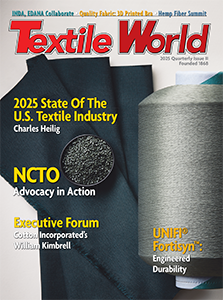T
his month’s Yarn Market finds ring spun to be the hot commodity, with the other
yarn-forming systems running lukewarm at best.
“Ring spinning, particularly combed ring spinning, is the only thing that has any real
substance right now,” said an industry observer. “Open end is suffering. Air jet is suffering.”
“Carded and combed ring-spun are in a pretty short position right now,” said another spinner.
“I don’t know what is going to happen to open-end. There seems to be too much of it out there.”
The business outlook at the spinning mills varies from a few weeks to one spinner’s opinion
that things probably will be pretty stable until the end of 2008, when the China safeguards expire.
“The specialty ring-spun business is good in terms of order backlog, but from our customers’
perspective, we are not as responsive as we need to be,” said one spinner. “Speed is our primary
strategic advantage.”
A Changing Landscape
This month, spinners polled for this column are in agreement that the spinning business is
changing, and that their business models must change accordingly. Approaches include recognizing
the need to partner and package, striving for flexibility, and migrating to specialty products.
“The old business model was to make a lot of yarn and sell it to about 100 different
customers,” said an industry observer. “Now there aren’t 100 different customers out there.
Spinners need to partner with knitters, finishers and cut-and-sew companies, and put packages
together so there is one voice going to the retailer.”
The physical layout and automation systems of many mills predispose them to the old
ton-and-gun approach, which no longer makes sense in today’s high-speed, low-volume environment.
Spinners are looking for ways to adapt operations to run more yarn counts and blends.
“The surviving US spinners have learned to accept change as their strategic identity,” said a
specialty ring spinner. “The product changes with shorter cycles and smaller volume, the customer
base changes, and customers’ customers change. Increasingly, our focus is toward speed and
efficiency, understanding that each order stands alone.”
The ultimate solution to avoid being trampled in a commodity marketplace is to specialize and
find a niche. Of course, the niche must pay better than the commodity business and have some
significant barrier to entry in the form of expertise, equipment, patent or trade protection.
“We’ve moved to more differentiated specialty products,” said a multisystem spinner. “More
and more, we are seeing that the commodity-type products are gone. The products that remain are
specialty, value-added products.
“Our model has moved to a more flexible operation with a changed back end so we can supply
more blends and more SKUs,” he continued. “It’s a strategic change to specialty products, quicker
turns and smaller runs.”
The DR-CAFTA Dance
Spinners expressed some confusion and dissatisfaction with the implementation progress of the
Dominican Republic-Central American Free Trade Agreement (DR-CAFTA). The trade agreement was
supposed to go into effect January 1, but it became stalled over a variety of issues including
intellectual property rights. This has caused the six Central American nations involved to make
legal and regulatory changes, adopting the agreement one by one.
“It’s a big disservice to the industry,” said one mill executive. “This waste of time and
effort is encouraging people to go directly to Asia and other parts of the world. People sourcing
product can’t wait for this to sort itself out.”
However, in the long run, most spinners still expect DR-CAFTA to be a winner for them.
“Our export business continues to become a larger percentage of our business,” said a
specialty ring spinner. “We are optimistic for continued growth as the apparel industry fully
benefits from the CAFTA legislation.”
Homeland Security Hookup
Legislation introduced recently by Rep. Robin Hayes, R-N.C., known as the Berry Amendment, would
require the Department of Homeland Security (DHS) to use American suppliers for uniforms, tents and
other textile products. This requirement could be a big plus for US spinners.
“This bill would extend the Berry Amendment sourcing requirements to Homeland Security and
other parts of the government,” said one spinner. “That would be huge for us. We have already seen
some benefit on some products that were slipping away, and gotten more attention from the
government. The publicity has generated some inquiries.”
On the pricing front, spinners are having a tough time passing rising fiber costs on to their
customers. This is the uphill battle that never goes away.
“It always amazes me how quickly the [yarn] price goes down, but how hard it is to get the
price back up,” said one spinner. “We have definitely seen a 10-cent increase in cotton prices
since August of last year. I don’t think we’ve seen a 10-cent increase in our yarn prices. I have
seen prices reluctantly begin to come up. Unless there is a real shortage in the market, it is
really difficult to get a price increase.”
April 2006




